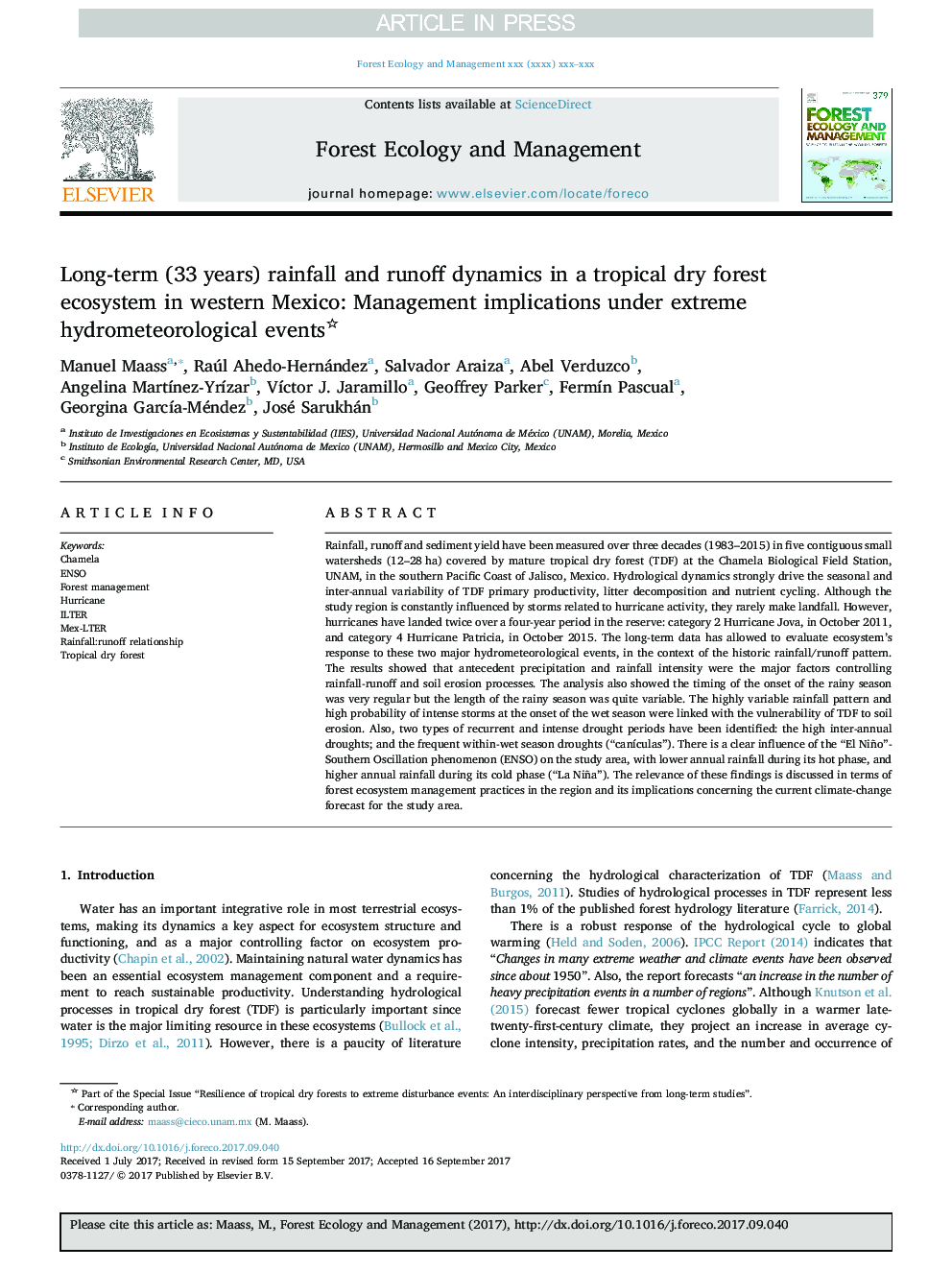| کد مقاله | کد نشریه | سال انتشار | مقاله انگلیسی | نسخه تمام متن |
|---|---|---|---|---|
| 6541538 | 1421334 | 2018 | 11 صفحه PDF | دانلود رایگان |
عنوان انگلیسی مقاله ISI
Long-term (33Â years) rainfall and runoff dynamics in a tropical dry forest ecosystem in western Mexico: Management implications under extreme hydrometeorological events
دانلود مقاله + سفارش ترجمه
دانلود مقاله ISI انگلیسی
رایگان برای ایرانیان
کلمات کلیدی
موضوعات مرتبط
علوم زیستی و بیوفناوری
علوم کشاورزی و بیولوژیک
بوم شناسی، تکامل، رفتار و سامانه شناسی
پیش نمایش صفحه اول مقاله

چکیده انگلیسی
Rainfall, runoff and sediment yield have been measured over three decades (1983-2015) in five contiguous small watersheds (12-28Â ha) covered by mature tropical dry forest (TDF) at the Chamela Biological Field Station, UNAM, in the southern Pacific Coast of Jalisco, Mexico. Hydrological dynamics strongly drive the seasonal and inter-annual variability of TDF primary productivity, litter decomposition and nutrient cycling. Although the study region is constantly influenced by storms related to hurricane activity, they rarely make landfall. However, hurricanes have landed twice over a four-year period in the reserve: category 2 Hurricane Jova, in October 2011, and category 4 Hurricane Patricia, in October 2015. The long-term data has allowed to evaluate ecosystem's response to these two major hydrometeorological events, in the context of the historic rainfall/runoff pattern. The results showed that antecedent precipitation and rainfall intensity were the major factors controlling rainfall-runoff and soil erosion processes. The analysis also showed the timing of the onset of the rainy season was very regular but the length of the rainy season was quite variable. The highly variable rainfall pattern and high probability of intense storms at the onset of the wet season were linked with the vulnerability of TDF to soil erosion. Also, two types of recurrent and intense drought periods have been identified: the high inter-annual droughts; and the frequent within-wet season droughts (“canÃculas”). There is a clear influence of the “El Niño”- Southern Oscillation phenomenon (ENSO) on the study area, with lower annual rainfall during its hot phase, and higher annual rainfall during its cold phase (“La Niña”). The relevance of these findings is discussed in terms of forest ecosystem management practices in the region and its implications concerning the current climate-change forecast for the study area.
ناشر
Database: Elsevier - ScienceDirect (ساینس دایرکت)
Journal: Forest Ecology and Management - Volume 426, 15 October 2018, Pages 7-17
Journal: Forest Ecology and Management - Volume 426, 15 October 2018, Pages 7-17
نویسندگان
Manuel Maass, Raúl Ahedo-Hernández, Salvador Araiza, Abel Verduzco, Angelina MartÃnez-YrÃzar, VÃctor J. Jaramillo, Geoffrey Parker, FermÃn Pascual, Georgina GarcÃa-Méndez, José Sarukhán,